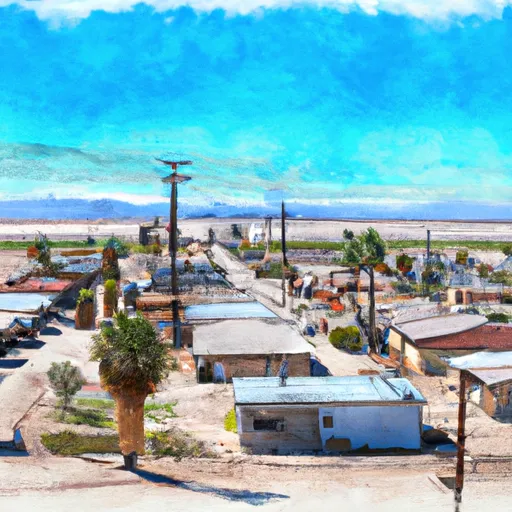-
 Snoflo Premium
Snoflo Premium
Get unlimited access to all our content
With no Ad interruptions! - Start Your Free Trial Login with existing account
Salton-City
Eden Index
Climate
7.0
•
Recreation
4.2
•
Community
0.3
•
Safeguard
4.4/10

Salton City is a small community located in Imperial County, California. It is situated on the shores of the Salton Sea, a vast body of water that was accidentally created in 1905 when the Colorado River breached its banks.
Salton City experiences a desert climate, characterized by hot summers and mild winters. Temperatures can often exceed 100°F (38°C) during the summer months, while winter temperatures average in the 60s°F (15-20°C). The region receives minimal rainfall, with most precipitation occurring during the winter months.
Hydrologically, the Salton Sea is a unique ecosystem. It is saline and has a high concentration of minerals due to its history as an agricultural runoff sink. The sea also faces challenges such as salinity, elevated nutrient levels, and declining water levels. However, it still attracts diverse bird species, making it a popular destination for birdwatching.
Outdoor recreation opportunities in Salton City include boating, fishing, and camping on the shores of the Salton Sea. The sea provides a habitat for various fish species, making it a popular spot for anglers. Moreover, the surrounding desert landscape offers opportunities for off-roading, hiking, and photography. With its diverse ecosystem and stunning natural surroundings, Salton City provides unique outdoor experiences for nature enthusiasts.
What is the Eden Index?
The Snoflo Eden Index serves as a comprehensive rating system for regions, evaluating their desirability through a holistic assessment of climate health, outdoor recreation opportunities, and natural disaster risk, acknowledging the profound impact of these factors on livability and well-being.
Climate Health Indicator (CHI): 7.0
Salton-City receives approximately
88mm of rain per year,
with humidity levels near 74%
and air temperatures averaging around
23°C.
Salton-City has a plant hardyness factor of
9, meaning
plants and agriculture in this region tend to thrive here all year round.
By considering the ideal temperature range, reliable water supplies, clean air, and stable seasonal rain or snowpacks, the Climate Health Indicator (CHI) underscores the significance of a healthy climate as the foundation for quality living.
A healthy climate is paramount for ensuring a high quality of life and livability in a region, fostering both physical well-being and environmental harmony. This can be characterized by ideal temperatures, reliable access to water supplies, clean air, and consistent seasonal rain or snowpacks.
Weather Forecast
Streamflow Conditions
Salton Sea
Area Rivers
Salton Sea
Snowpack Depths
Salton Sea
Reservoir Storage Capacity
Salton Sea
Groundwater Levels
Recreational Opportunity Index (ROI): 4.2
The Recreational Opportunity Index (ROI) recognizes the value of outdoor recreational options, such as parks, hiking trails, camping sites, and fishing spots, while acknowledging that climate plays a pivotal role in ensuring the comfort and consistency of these experiences.
Access to outdoor recreational opportunities, encompassing activities such as parks, hiking, camping, and fishing, is crucial for overall well-being, and the climate plays a pivotal role in enabling and enhancing these experiences, ensuring that individuals can engage in nature-based activities comfortably and consistently.
Camping Areas
| Campground | Campsites | Reservations | Toilets | Showers | Elevation |
|---|---|---|---|---|---|
| Lake Cahuilla County Park | 56 | 2 ft | |||
| Mecca Beach - Salton Sea State Rec Area | 110 | -223 ft | |||
| Palm Beach Dry Camp | 30 | -220 ft | |||
| Headquarters - Salton Sea State Rec Area | 40 | -223 ft | |||
| Ocotillo Wells State Vehicle Area | None | 360 ft | |||
| Ocotillo Wells OHV Dispersed | None | 151 ft | |||
| Painted Canyon | None | 566 ft | |||
| Corvina Beach - Salton Sea State Rec Area | None | -221 ft | |||
| Box Canyon Dispersed | None | 258 ft |
Catastrophe Safeguard Index (CSI):
The Catastrophe Safeguard Index (CSI) recognizes that natural disaster risk, encompassing floods, fires, hurricanes, and tornadoes, can drastically affect safety and the overall appeal of an area.
The level of natural disaster risk in a region significantly affects safety and the overall livability, with climate change amplifying these risks by potentially increasing the frequency and intensity of events like floods, fires, hurricanes, and tornadoes, thereby posing substantial challenges to community resilience and well-being.
Community Resilience Indicator (CRI): 0.3
The Community Resilience Indicator (CRI) recognizes that education, healthcare, and socioeconomics are crucial to the well-being of a region. The CRI acknowledges the profound impact of these elements on residents' overall quality of life. By evaluating educational resources, healthcare accessibility, and economic inclusivity, the index captures the essential aspects that contribute to a thriving community, fostering resident satisfaction, equity, and social cohesion.

